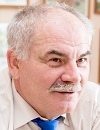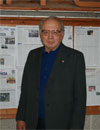 |
||
|
Victor Murogov: Shift in Priorities AtomInfo.Ru, PUBLISHED 31.12.2016 Professor Viktor Murogov joined the IAEA in 1996, i.e. twenty years ago. Today, at the request of AtomInfo.Ru correspondents, Viktor Mikhailovich is recollecting his work for the Agency - from minor events to actions that caused radical changes in the line of the IAEA activity. In lieu of the foreword Twenty years ago, by the assignment of Minatom (Russian Ministry for Atomic Energy), I joined the IAEA as Deputy Director General and Head of the Department of Nuclear Energy (DNE) and also Manager of the IAEA's Major Program 1 (MP1) "Nuclear Power and Fuel Cycle". For the years of work in the Agency, I accumulated vast archives of documents including those on the DNE's scientific, technical and organizational issues and initiatives over the following trends: - development of INPRO (innovative projects for NPPs and NFCs), - development of the IAEA's Program on Nuclear Knowledge Management (cross-cutting program), - elaboration of a new trend called "Comparative Assessment of Nuclear Energy Role for Sustainable Energy Development" (Program C - MP1). The archives accumulated helped create information databases at the MEPhI International Center of Nuclear Education and at the Center for Nuclear Knowledge Management of the Obninsk Institute of Atomic Energy (IAE) . At those centers, young talented researchers are involved in the assessment and development of ideas enclosed in the above programs. The direct supervisor of this work is A.A. Andrianov, Cand. Sc. (Phys-Math), associate professor at the IAE. Owing to his contribution, it became possible to analyze materials required for a recorded history of the IAEA activity over the aforementioned trends in 1996 thru 2003, and retrace the results of that activity up to the present. Viktor Murogov, April 2016 Viktor Murogov. 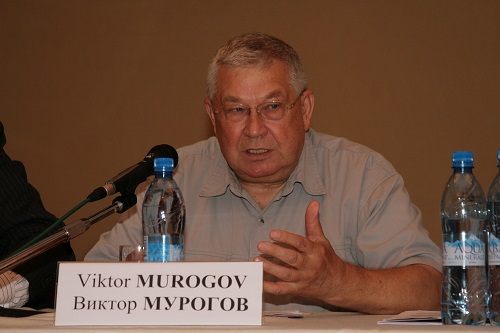 Problem of priorities Viktor Mikhailovich, you came to the IAEA 20 years ago… Yes, my work for the Agency commenced on January 1, 1996. I was to hold three offices at the same time: Deputy Director General, Head of the Department of Nuclear Energy ("Russian" department), and Manager of the Major Program 1 "Nuclear Power and Fuel Cycle". What was the situation in the Agency then? What was the IAEA engaged in? For a more clear understanding of the situation associated with my joining the Agency, two aspects of the matter should be considered. On the one hand, I was not a stranger - I was recommended by the then Minister for Atomic Energy Viktor N. Mikhailov as the Head of the Institute of Physics & Power Engineering in Obninsk, the largest national nuclear center engaged in the development of fast reactors (seven departments, each comparable with an independent research institute, about 9,000 employees, over 400 doctors and candidates of science at that time). I had sufficient experience in managing a large organization with considerable financial & logistic resources; I was quite experienced in solving research problems, holding talks with top officials of Russian nuclear industry and heads of international organizations; I participated in the IAEA projects and had personal contacts with the IAEA leaders such as S. Eklund and H. Blix. On the other hand, I came to the IAEA's Department of Nuclear Energy (DNE) traditionally headed by, consequently, Soviet and Russian representatives. It is worth mentioning that Russian nuclear industry had a broad representation in the IAEA in that period: about 90 (of 800) experts, which reflected Russia's economic potential and the fact that each forth nuclear specialist worked in the Russian Federation. My predecessor Boris A. Semenov had extensive experience (more than twelve years) in international nuclear activity including his work for the IAEA. Before the IAEA, he was the Head of the RF Minatom's Department of Foreign Relations (his predecessor was M.N. Ryzhov). Considering vast experience gained by B. Semenov, I appointed him (despite objections on the part of Hans Blix who called it "contradicting to the Agency traditions") first an adviser at my office and then a head of the group supervising provision of aid to Russia to improve radiation environment. Organizational changes in the Agency took place under the influence of most acute events. The DNE's Safety Division, headed by Morris Rosen from the USA (who also was H. Blix's advisor) was raised to the Department of Nuclear Safety & Security - DNS, and Mr. Rosen was appointed Assistant Deputy Director General of that Department. On my first working day, I was said: "Dear Professor, all our programs are of two years' duration, and that's why we ask you to familiarize yourself with the program of work and abstain from any revolutionary changes". Global nuclear industry was going then through hard times after such heavy blows as TMI-2, Chernobyl, and Iraq. Safety and Security, i.e. safety and physical protection became priority lines, and it was quite natural that the IAEA focused on them. When I was told that safety was the priority and responsibility of DNS, I got surprised as I was sure that safety was primarily determined by advanced technologies. Still, I managed to find a common language with Morris Rosen. Unfortunately, his term of office in the new Department appeared rather short. He was succeeded by the Canadian Representative Zygmund Domaratzki, who earlier worked as the Director General of the Atomic Energy Control Board of Canada. In fact, he was a supervisor in the pure form. It should be said that our personal relations were good and correct, but each of us became tough in promoting departmental interests. "Viktor", - he said when we first met, - "it is safety that matters whereas technology is subordinate to it". "OK", - I said, - "What airplane is most safe to you mind?" and answered myself: "It is an airplane standing permanently on land. But it is of no use to anybody. Just the same with your nuclear energy: if it is only safe but unprofitable, it won't be of interest and would be shut down in the course of time". It was the beginning of a war of interests as part of program activities. About a year later, Domaratzki submitted a report to the Director General indicating, in particular, as follows: "Safety is absolute priority. The Department of Nuclear Energy should work under the financial and program supervision of the Department of Safety & Security". Nuclear-safe conflict And is it possible? Heads of the IAEA Departments are appointed in compliance with quotas for Member States… Domaratzki did not apply for a position or management. He undertook a politic move by proposing to grant him the right to financial monitoring & distribution over all safety-related issues. The IAEA-adopted approach was as follows. Let us assume that DNE has a waste program. DNS can participate in it but the distribution of resources is vested in the head of DNE. The reverse order is possible as well: DNE can take part in DNS programs but it is the latter that would dispose of resources. By the way, during the DNE reorganization before my appointment, the newly established DNS "inherited" - along with corresponding structures - very experienced specialists such as Annick Carnino from France (now she heads the French Civic Supervision of NPP Safety) and Abel Julio Gonzalez, a real Argentinian hidalgo, a very experienced nuclear expert, who devoted most of his life to the problems of nuclear safety and radiation protection. As a result, employees and heads of sections in both Departments preserved good business relations. However, notwithstanding the mid-level managers' desire to keep participation in programs at the former level, the general tendency - highest priority to safety - was leading to the reduction of the "technology" trend. As to me, I was trying to extend - whenever possible - technology issues. Take, for example, the problem of waste. Though nuclear & radiation safety is of great importance there, an advanced technology would be required for long-run solution of the problem. A similar problem for the Agency discussions of those days: who should be responsible for NPP safety, nuclear regulator or operator? The conflict rose up to the ElBaradei level. For me, it was my first serious talk with the new Director General. "Viktor, your colleague Domaratzki thinks that you should work under his financial supervision. We can't transfer employees from one department to another, but he wants to get entire control of funds", said ElBaradei. What should I proceed? Actually, the matter in question concerned putting the IAEA's "Russian" department (DNE) under outside financial and program control. The way out should be found at once. "Dear DG (Director General), I think that one Dr. ElBaradei is quite enough. I don't need a parallel chief." The answer was to the liking of ElBaradei but not to Domaratzki's. What was the end of this story? Sometime after that, Domaratzki retired for health reasons. He was sorry for himself but could not agree to the rejection of his proposal. You asked me about the situation in the Agency at that time. Just imagine what it was like if I not once had to intercede at the Director General (DG) meetings for employees facing dismissal for a principal position. Supposing we fire a specialist, formerly a very experienced chief engineer of a big NPP. And who will remain? Outstanding administrators? Even at the time we could observe discussions on the role of the so-called "phony managers" (a mixture of manager and salesman). Now I speak of a real incident - an attempt to refuse renewal of a contract with some employee for "incorrect behavior" because that employee lost his temper and called such "phony manager" a non-professional. Agency Information and its role The IAEA Department of Nuclear Energy was traditionally considered as "Russian". Certainly, the DNS separation weakened its position. There was no use opposing the General Conference's decision, and H. Blix (Director General in 1981 thru 1997) told me: "Viktor, you'll have to live with this reality". But that was not the end of problems. The Department of Management is traditionally considered "American" - by analogy with the "Russian" Department because its Head is appointed on behalf of the United States and is not elected by the Board of Governors. Moreover, the US's contribution to the IAEA is one of the largest, and Americans arrived at an idea about an excessive influence of the "Russian" Department. The point is that the Department of Nuclear Energy historically incorporated a library and the world's largest nuclear information system INIS as a basis for scientific-technical activity in the field of nuclear power. Americans proposed (the decision was taken during DNE separation) a scheme under which Russia would retain those subdivisions but it is the Department of Management that would determine for them plans of actions because "the Agency should have common information support". I tried to object: "You are going to establish common control over provisions of office equipment, foodstuffs for dining-rooms and nuclear technology?" Arguments were not taken into account, and control over subdivisions became dual: employees' work supervised by DNE while programs of work and funds, by Americans (Department of Management). I did not lose heart. For three years, I regularly rose up this question at the DG meetings and wrote memos. I placed emphasis on the fact that in the Member States' opinion, this strange symbiosis of atom and sausage pointed to the lack of professionalism in the Agency, reducing efficiency of work and protection of sensitive information (especially in the context of terrorist attacks of September 11, 2001). The last circumstance along with my insistence and regular reports, probably, helped breach the wall because my opponents decided to meet half-way and commence negotiations. The essence of discussion looked as follows. "Dear Viktor", they would say, "to make you understand the subject-matter, we are ready to tell you what we need INIS for". "I know this. The INIS Project was launched at the request of developing countries to facilitate distribution and exchange of nuclear information". "Yes, it is specified so in the Statute. Actually, INIS is an indicator of nuclear activity the world over. We want you to see yourself how it is realized in practice. During the next business trip to the US, I visited a certain National Lab, where I was shown departments engaged in the assessment of data and forecast of situations in various fields of activity all over the world. Weather forecast and agriculture in Africa were taken as an example. "Weather forecast, crop yields, invasion of vermin… What influence can these factors exert on the population and on a political situation?" "Viktor, we are to know where this or that kind of aid is needed". On the IAEA demands, the world's leading nuclear labs carry out a good deal of analyses of nuclear activity the world over, and the INIS project is one of data-flows for those analyses. "If you are planning to return INIS to your department, you should think about responsibility you would take for part of our work. We don't object; we are pleased to see that it is experts who are making analyses provided they know exactly what those analyses are required for". And what was the end of this story? In the library and in the INIS project, I am still called the man who succeeded in separating scientific & technical information (books) from sausages. With E.P. Velilkhov, President of the Kurchatov Institute, and Assistant Yanko Yanev. 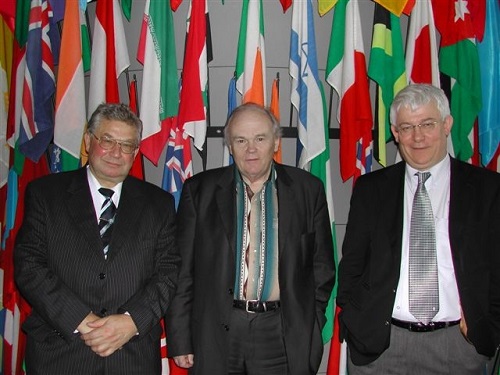 Formation of the Affinity group as a basis for reviving the role of the Department and its program - as the basic IAEA program How did you start your work as the Head of the Department and the Manager of Program MP1? No matter what my home experience might be, I realized that I almost rushed into a hell of problems - from the head of a research institution to practically the highest "nuclear" post to be taken by a Russian representative in an international organization like the UN or IAEA. The formation of a group of like-minded professionals was evident to me. To avoid misunderstanding of the situation with the IAEA personnel, I must say that many positions in the Agency were and are occupied by skilled professionals who passed through a tough selection. If, for example, an employee from Argentina or India worked in DNE, I was sure that in his country he was considered one of the best specialists. The IAEA managers were also noted for a high skill but with national traditions and peculiarities (graduates from national schools). Similar to any UN structure (about forty organizations), the Agency sometimes failed to get adapted to operating principles they brought from their native countries. The IAEA's competitive personnel selection was rather flexible and rational. As a result, a team entitled the "DDG-NE Office" was formed in a fairly short period. The team incorporated as follows: -- two high-skill technical secretaries (knowledge of several foreign languages, experience of international and diplomatic work over fifteen years); - two advisors in administrative and financial issues (Cambridge education and fine English); - two advisors in coordination of program activity (former Deputy Director Generals of DNE and DNS); - advisor - coordinator of interoffice activity (level of a Minister of nuclear energy in a West-European country). In addition (which was unusual for the Agency), I established weekly meetings attended by the whole of the DDG-NE Office and heads of all DNE divisions and sections with the issue of protocols and decisions available on the IAEA employees site for information and control of execution. An unexpected effect showed up in half a year, when the administration of the IAEA buildings (building A, our floor A-26) informed us that ventilation systems would supply air to the Agency buildings till 19:00. As a result, work after 19:00 became impossible due to the lack of fresh air. The explanation was as follows: "Viktor, similar to you, your employees keep late hours thus breaking corresponding trade-union rules. For moral reasons, they cannot leave the office while you are here". Since then, we finished our working day at 19:00. At first sight, all I am speaking about is just trifles. It is not so. We had great ideas aimed at rekindling the glory of the "Russian" Department along with its key role in the IAEA activity, but we were first to solve organizational issues and improve the working process. Here is an example. Under ElBaradei, an experienced manager, former Minister for Atomic Energy of Algeria was appointed head of the Planning Section. His work style was to ElBaradei's liking because they both followed one and the same management strategy "Programs should be result-oriented". This concept, which was popular in many organizations and institutions, reappeared not long ago. For instance, from their point of view, it was inadmissible to be constantly involved in one reactor type, e.g. PWR/VVER. Reactor types should be regularly changed in the program. I was surprised: "It means that in the 1st quarter I finish gathering data on PWR, and in the 2nd quarter I should pass to the developments of fast reactors? It is like an anecdote!" Still further, the Planning Section elaborated and introduced a scientifically based system of points, criteria etc. to assess employees' labor efficiency and also other things that could be of interest to "phony managers". All the above was rather interesting until my employees complained at one of regular meetings: "Viktor, we have no time for work, we spend all time on filling various forms and making reports - on planning, fulfillment criteria, and so on". As a result, we accepted a proposal from my financial advisor, a very clever Englishwoman who graduated from Cambridge and, besides, finished two schools of management. Earlier she worked as S. Eklund's secretary. In my Department, she supervised coordination of the administrative staff and also headed the informal association of the IAEA secretaries. By the way, a personal experience of such professionals is worth much. Just at the beginning of her service in the DNE, she stated, "Viktor, all our talks here become known to the Director General. All papers on your table are copied unmoved. That's why we'll speak about things we wish to be heard by the Head of the Agency". "Fine," I answered. "If I want to promote some idea, I'll discuss it with you, and the DG will immediately learn about it". The solution was simple, under Arkady Raikin's principle "Our outgoing document against your incoming document". We receive from the Planning Section a successive document containing either an initiative or an inquiry, and write a response thereto. But it is performed by the existing office headed by an administrative advisor who should undertake this task. At a regular DG meeting half a year later, the Head of the Planning Section takes the floor and starts to harshly criticize everyone: "I write papers and elaborate methods, and the DG approves them. As a result, Departments ignore those documents except for Viktor-headed Department, which provides - in due time - complete and substantive answers. I think, dear DG, that the practice applied in the "Russian" Department should be spread to other IAEA Departments. Nowadays, many institutions are to fill a lot of forms. When I am asked about actions to be taken, I recollect my practice in the IAEA and say: "Establish an office, which would fulfill the whole of paper work". Essence of program work What's new in work at program-specified tasks? When I began my work at the IAEA, I tried to get acquainted as soon as possible with all Department employees to appreciate better their role in the current program fulfillment as well as to learn about their problems and plans for the future. I encountered open discontent on the part of two talented (I wrote their publications) employees - a Belgium man and a French woman. They at once warned me that they would leave the Agency for work in NEA (Paris). Work they were involved in the IAEA and were going to proceed in Paris included a comparative assessment of energy options. They were trying to prove that the role and problems of nuclear energy could be determined correctly only by comparing it with other energy options. At present, it is considered as self-evident. But remember the start of our conversation. At that moment, the Agency was obsessed by the words "safety" and "physical protection". On the other hand, many nuclear facilities and organizations were recommended to continue concentrate interests within the nuclear sector. What conceptual approach to the comparative assessment could be considered under such conditions? For me - personally and as MP1 manager - availability of a comparative assessment and possible loss of that trend were of great significance. The matter is that before 1996 (start of work at the IAEA) I was a researcher at the National Research Nuclear University MEPhI, and was engaged in joint analyses of different types of fast reactors and nuclear fuel cycles (uranium, thorium, and mixed). In those analyses, we employed the systemic approach as we realized that no matter how brilliant could be characteristics of a nuclear reactor (NPP with that reactor), the decisive factor was the said reactor (NPP) integration into the general nuclear energy system (complete with the nuclear fuel cycle). A vivid example for us was the decision by the Scientific Advisor of the USSR's Fast Reactors Program A.I. Leipunsky who proposed using oxide ceramic fuel in fast reactors BN as it was widely used in home nuclear power plants with water-moderated reactors VVER. That decision predetermined successful implementation of the fast reactors program in the USSR (Russia) starting from reactor BR-5 (1958) - contrary to the dead-end program in the USA based on the "beautiful" (judged from the fast reactor physics) metallic fuel. Later on, this system approach became one of the main trends in my investigations in association with researchers from the Siberian Power Institute (Irkutsk) noted for a powerful school of systemic analysis guided by Academician L.A. Melentyev, and also in joint work with Academician L.S. Popyrin (Moscow). With the above in view, one of my first independent steps in the IAEA was the desire to preserve the existing "stock" of comparative analytical work and, besides, create Program C, a new priority trend within Program MP1. As an addition to Programs A (nuclear power) and B (nuclear fuel cycle), Program C was to incorporate a comparative assessment of energy options including alternative trends in the nuclear power industry. To conduct that investigation, I invited the German Professor Hans-Holger Rogner from Canada, known for his work on sustainable energy development (Conferences in Rio de Janeiro, 1991 and in Helsinki, 1993). H. Rogner's fame was of a dual nature. Environmental groups regarded him as an advocate of nuclear energy while nuclear workers disliked him for provocative questions. For example, his favorite question, which drove them mad, was "If everything is fine with nuclear power, why don't we see a boom in NPP construction?" In short, I invited him to work at the IAEA, and he gave his consent. A competition was announced, and H. Rogner became the winner. During a conversation, which preceded the competition, I for the first time met face to face with H. Rogner. We both were familiar with each other's papers, and our viewpoints had much in common. I explained to H. Rogner what I would like to see in the end. We agreed that the IAEA top officials should get familiar with the results of work gradually as comparison makes sense only if something is compared to something. There is no "simply best technology"; it should be more advanced against another one. H. Rogner made a report for the Director General, where he compared nuclear power with coal- and gas energy and showed where and in what countries it has an advantage. ElBaradei took interest in that report. "Viktor, where did you take these data?" he asked "No one saw them in my office". "This report was prepared by a new IAEA researcher". "OK, let him write speeches for me from time to time". It's interesting to know the progress of this trend and its introduction into the IAEA Plan of Actions… Unfortunately, the above trend encountered strong opposition in the IAEA on the part of two leading nuclear nations - USA and Russia. A sharply negative response came from DoE. Still, I should give respect to J. Ritch III, the US Ambassador to the IAEA, who came to my office and gave backing to the newly established trend C. With the letter from DoE in hand, he said that "fools are everywhere including DoS". Support from J. Ritch, his comprehension of the IAEA objectives in nuclear power development appeared of great value for the progress of MP1 including the arrangement of first Scientific Forums in the IAEA in 1998 and 1999, where perspectives of nuclear power were analyzed (a comparative assessment was also used). Since then, Forums became a significant event held regularly during the IAEA General Conferences. At first, Russia's and US's negative reaction was similar: "It is squandering of funds, and we refuse to participate". The IAEA received a devastating letter from Minatom's Department of Foreign Relations, which the Department Head M.N. Ryzhov passed over to me - as the MP1 manager - and to the IAEA Director General. In that letter, the total of the MP1 program was assessed as unsatisfactory. The reason: instead of focusing attention on innovations and promoting new developments (including reactors with inherent safety, which presumed lead coolant reactors), MP1 attaches much effort to an assessment of nuclear power as compared with traditional energy sources. Moreover, the RF Minatom found this trend "destructive" for the Agency and refused to send Russian experts to the meeting on the coordination of work under Program C (April 1999). However, in May 1999, a sudden letter from the RF Academy of Sciences was received with the support of Program C and the desire to take part in it. Within a month, the RF Minatom shifted its ground and informed about the desire to send Russian experts (at a research institute director's level) to the meeting in question. It is interesting to note that the first results of work within Program C (supervised by H. Rogner) were included in the Energy Assessment Report - the main UN paper on the assessment, role and perspectives of global nuclear energy as a separate section about nuclear energy - one of the basic factors of sustainable energy development. Prior to that, regular UN surveys of nuclear technology contained only two references of nuclear power: a source of nuclear weapon and an origin of nuclear waste. The IAEA Director General expressed his gratitude to H. Rogner (supervisor of work within Program C) and later frequently used the Program C results in his reports and declarations. H. Rogner acquired recognition as a fact-based nuclear expert, and became a permanent participant in numerous events devoted to sustainable energy development and to environmental problems of nuclear power. Nowadays, Section C in the DNE is one of major concept-based IAEA divisions (and trends of the Agency activity). 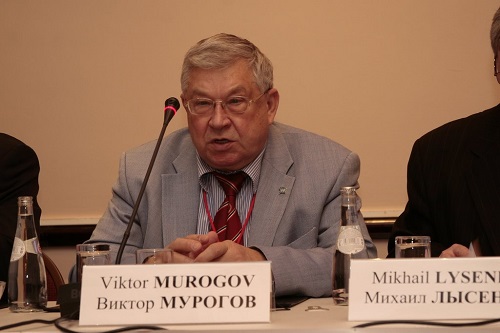 Disputes with nuclear industry Activity going on, reports being prepared, the Director General delivering those reports, but no program of work. It was then that I proposed arranging a series of multilateral meetings to discuss the new trend of planned wok called "Comparative Assessment and Role of Nuclear Energy in Sustainable Energy Development" with the involvement of representatives from the IAEA Member States. We sent out letters of invitation to the Member States. After TMI-2, Chernobyl, and Iraqi events, the IAEA focused on the problems of safety and control. The nuclear industry, in its turn, used existing reactor types as the primary argument: "Come to us, and we'll discuss everything". We held two meetings with leading nuclear companies attended by representatives from COGEMA, General Electric, and other big companies. Discussions went on under the same scenario: the industry would speak about economic interests only. Industrialists were always ready to discuss metal consumption, but the question "To be or not to be?" did not trouble them. "You are forcing safety upon us", manufacturers would say. "Do you know that earlier the safety criterion in designing had quite another meaning? You imposed the so-called safety culture upon us, but do you know the cost of it for us?" The US industrialists would state frankly and straightly. Starting from 1979, when the safety issue became a high-priority task, the cost of a single power unit was yearly rising by 10 percent. "And you have the nerve to speak about non-proliferation", would say US manufacturers getting excited. "Does the non-proliferation mode spread on coal-fired power plants? Or, God save, on wind-powered plants? And you tell us about non-proliferation. If this is the case, power units would become ever more expensive". "Non-proliferation is a matter of the government. We would build nuclear plants, and let politics suffer from a headache", insisted manufacturers. After the Agency had issued a report "Design of water-moderated nuclear reactors with due account for the non-proliferation regime", the nuclear industry flied into a rage: "You are going to cut down nuclear energy?" "No, we want it to comply with the criteria, and we give you these criteria". "Then develop reactors with such criteria yourself!" We were leaving those meetings followed by the industrialists' instructions: "Raise questions about innovation reactors to correspond to your criteria, and don't poke your nose into our business". Little tricks of the round table talks So, what did we have? The Agency is responsible only for the elaboration of criteria and not for the development of technologies. In its turn, nuclear industry was not going to develop new reactors corresponding to our criteria, and considered the current state of things satisfactory. It was necessary to arrange a multilateral meeting with a wide representation of IAEA Member States and - which was the key moment - a discussion of high-level experts, a kind of round table talks between the leaders of nuclear science & technology and nuclear officials. In 1998, we agreed with John Ritch to try to arrange a round table during the IAEA General Conference. Nowadays, you know it under the name "Scientific Forum". Earlier, there was no such a forum, and it was our round table that gave birth to it. We decided to invite leaders of nuclear sectors from major nuclear nations so that they could discuss how to proceed. John Ritch guaranteed the presence of western leaders, while I was to persuade E. Adamov. "If things work out, I will provide publicity", promised John Ritch. In 1998, the RF Minister for Atomic Energy was Evgeny O. Adamov, who was anxious to restore the power and glory of the USSR Ministry of Medium Machine-Building (predecessor of the RF Minatom). I said: "Evgeny Olegovich, just imagine how you arrive in Vienna, accompanied by academicians, and speak during round table talks about Russian nuclear technology, its development and achievements after Chernobyl". The situation was partially overlapped by the political aspect. After the Chernobyl catastrophe, western nations gave 10 million USD "to raise safety of Soviet reactors". When the Program was fulfilled, financial aid was reduced to 100 thousand USD. "Evgeny Olegovich, just think", I complained. "They propose selling the image of Russian nuclear energy just for one hundred thousand dollars. Do you realize what is going on? At a meeting of the Board of Governors, our diplomat declares that Russian nuclear energy is safe, and immediately hears an acrid voice from the European corner: No-no-no, here is the joint report running that it is dangerous and needs aid". Yeah, aid worth… one hundred thousand dollars. E. Adamov became enthusiastic over the opportunity to speak publicly on the new Russian situation, and he agreed to participate in the session. The General Conferences starts its work. The first day is devoted to summary reports and speeches by leading delegates, and we keep heads down. Our objective is the second day, when formal speeches are over but most participants remain in the Agency. In the session hall, reports from Member States are read from a piece of paper, and they are listened by duty delegates, others minding own affairs on the margins. As an experienced fighter, John Ritch takes the initiative: "Viktor, after dinner, we'll take a small hall so that it could not accommodate all interested persons. I'll ensure the presence of ElBaradei. Don't reserve a seat for him; he must see that that hall is packed. When ElBaradei enters, give place to him. And then lean on me". Everything happened just so. The hall is packed, E. Adamov is inside. US representatives are also there as they cannot miss such an event. Two hundred seats and far too many who wished to get there. In ten or fifteen minutes, enters the two-meter-high John Ritch followed by ElBaradei. John Ritch: "Dear DG, delegates will discuss in that small hall what should be done in a large session hall". Almost immediately Minister E. Adamov starts delivering his report, followed by N.N. Ponomarev-Stepnoy and US representatives. Discussions, disputes… In short, just like old times. And the beautiful John Ritch beats the audience down: "Look, what the session has turned into! But the room is not sufficient for all participants, so many people standing, and we've hardly found an empty seat for Dr. ElBaradei." "Dear DG, we are discussing the essence of the Agency work in this small room. And here you can see your potential. Try not to lose it!" At the following meeting next morning, John Ritch took the floor outside the agenda: "Dear Sirs, you are sitting here while the future of nuclear energy was being determined yesterday in another hall. I demand that the resolution taken during the round table talks be presented and adopted at this session". The proposal was supported and the resolution adopted. A decision was made to hold a Scientific Forum within each session of the General Conference. And it goes on so since.
From the letter by RF Minister for Atomic energy Evgeny Adamov addressed to the IAEA Director General Dr. Mohamed ElBaradei. On the way to INPRO What happened next? How were the results of the round table talks (new Scientific Forum) embodied in practice? Through joint efforts, we reversed the situation. By 1998, the IAEA had realized that it should regain its role as a flagship of nuclear energy development. The results of our activity in 1998 and early 1999 led to our Department's understanding of the Main Program 1, of the necessity to assess the content and the role of innovative NPP & NFC technologies based on the systemic approach. An official proposal to launch a project on innovative nuclear fuel cycles and nuclear power plants was sent to the IAEA Director General. Front page of Viktor Murogov's Memorandum of April 27, 1999 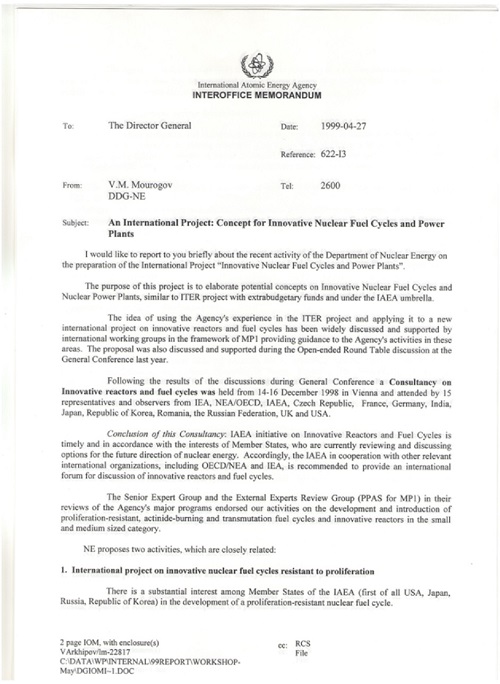 We were steadily getting ready to start up a project, which was soon called INPRO. Preliminary consultations showed that activity within that project attracted attention of fifteen Member States (later their number increased to eighteen). Certainly, participants had own viewpoints on the innovative reactor. Some counted on small-power reactors, other dreamed about nuclear desalination, still others did not forget high-temperature gas-cooled reactors. Russia proposed a lead-cooled reactor. In 1998 thru 2002, in association with Paris and Brussels energy agencies, we fulfilled a joint project named "Innovative Nuclear Reactor Development". The joint work was completed by the issue of the-called "Three-Agency Report". As a result, we in the IAEA Secretariat came to the following conclusion. Of course, each country has own trump cards, and it is difficult to say who holds senior trump cards. But it is not of great importance now. The most urgent thing now is explaining to a hundred and fifty countries what nuclear energy is for and what we call nuclear energy of the future. Only then would we understand what reactor types we should develop and what requirements a nuclear newcomer should follow before it starts developing national nuclear energy. By the way, the last point is of great importance. At a time, the situation with isotopes (with medical radioactive isotopes, in particular) was a matter of hot disputes. Countries produced isotopes not always providing proper control over them. Radioactive isotopes registers were not used in some developing countries. There were cases when the lack of radiation therapists' expertise brought about fatal outcomes among patients because of a miscalculated dose. The IAEA adopted a resolution under which any aid related to radioactive isotopes should be provided only after elaborating a program for training of specialists. By the way, later that resolution became a basis for the Nuclear Knowledge Management Program. One could see a gradually forming shape of that new (for the nuclear community) program: systemic approach and knowledge management. The latter theme was to the liking of the IAEA Departments: "Any information work is management of knowledge. It is just what we are involved historically. What is the new here? Why should we change anything?" We had to struggle for retaining the essence of the new program. As an example, I took the development of fast reactors. Do they operate anywhere in the world? Actually, they do not exist (only BN-600 was then). We call those reactors the future of nuclear energy, but they were designed forty years ago. And where is knowledge on fast reactors? This knowledge is vanishing and is getting lost though it is critical for the industry. I remember a meeting with the head of a certain US National Lab: "Viktor, I'll support you. Probably, you don't know that when the US Program on fast reactors had been closed, one of designers brought home two light trucks with project documents, which DoE officers were ready to throw away as waste". It is known that after the completion of the Apollo Program, up to 80% of knowledge gained during the project was lost in the US". We formulated the task as follows: "To develop innovative nuclear energy, first it is necessary to preserve basic knowledge". The "Red Book" of nuclear knowledge should be compiled, which is the most pressing challenge for critical nuclear technologies determining full-scale development of nuclear reactors. We observe the loss of knowledge which is not used. In the nuclear sector, it is reactor technologies that suffer most of all from this. Russia's construction of reactor BN-800 is an example of the preserved knowledge on fast sodium-cooled reactors but, unfortunately, this is unique experience. Thus, it became the basis for another priority trend of the IAEA activity - Nuclear Knowledge Management (NKM), which is the theme of the primary resolution of the General Conference 2002 and a subject-matter of the first international conference on NKM in the IAEA in 2004 The tasks were specified. There was only one problem: lack of resources. The IAEA budget is drawn up for two years. Even if you convince the Director General of the necessity to develop this or that project, he would not be able to help you until a new budget is passed. For such cases, non-budgetary funds are envisaged. If a country finds the work in question important, it can make an extra contribution. This mechanism is frequently used by the leading IAEA donors such as USA and Japan. Supposing you want to place a spent fuel processing complex under the IAEA safeguards, here are extra-budgetary funds. But do not think it is so easy. Let us return to the Japan example. When information about certain Member States' desire to contribute additionally to the program of the Safeguards Department becomes known, a proposal from developing Member States appears in the Secretariat. The balance of the IAEA program may be subjected to changes, which is inadmissible. It is suggested that the proposed extra-budgetary resources should be divided into two parts, the second part being distributed among developing states. And only try to oppose it: the number of developing countries exceeds eighty. Russia could render financial support to the future project INPRO. To this end, first, it was necessary to make Moscow believe in the project usefulness and, second, to convince the Secretariat accept funds and spend it purposefully. Looking ahead, I should say that the Russian initiative and financial support of INPRO vexed Washington greatly. During one heated dispute, when the situation came to a head, an officer from DoE, trying to offend me, threw an abrupt remark: "What do you want? To become a leader in determining the future of nuclear energy owing to one million dollars contributed a hundred years ago?" "We, Americans and Japanese, annually allocate to the Agency tens of millions of dollars but we are called "nuclear" policemen. And you, with the one-million contribution, are going to lead a struggle for the interests of developing nations? Not realizing the consequences, the offended quick-tempered officer gave us a brilliant idea. With the help of Indian delegation, we introduced a small but very important addition to the UN resolution in New York: "the IAEA initiative over INPRO meets expectations of developing countries". When Americans calmed down, they realized how elegantly they were outplayed. Indeed, systemic investigations do not require large resources. On the other hand, everything is correct: the IAEA may not be engaged in R&D work. Still, the development of INPRO is another interesting story. 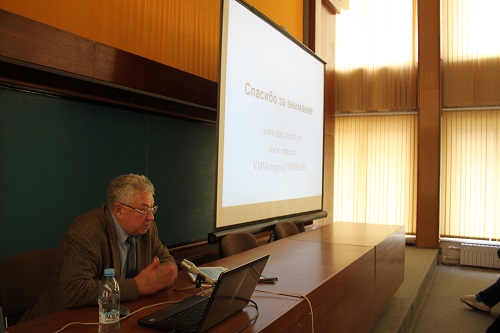 Topics: IAEA, Interview, Victor Murogov Other news: 443 nuclear units are operating in the world Another 65 units have the status of the being built one. New American submarine will be named after admiral Rickover 60th anniversary of the first trip of the nuclear submarine Nautilus. Westinghouse will deliver CE16NGF fuel on Palo Verde This is a new generation fuel for 16×16 grid. |
Hero of the day 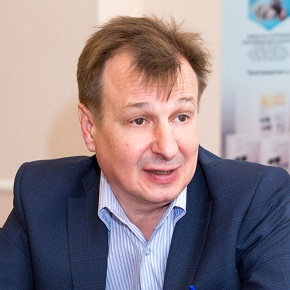
Dmitry Klinov: BFS is being renewed The task of the BFS retrofitting and upgrading arose in late 2010 as a consequence of the enormous difficulties that we had encountered in renewing the licence to operate our fast critical facilities. INTERVIEW
Oleg Grudzevich OPINION
Rudolf Baklushin |
